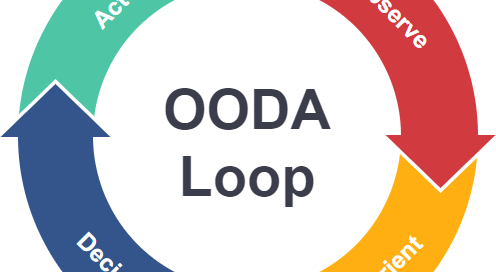This week’s toy: a way to create immersive video environments. What if you could create personal video rooms on any site and didn’t need to use Zoom or Google Meet? It would be interesting to see where video interactions pop up. Edition No. 20 of this newsletter is here - it’s November 14, 2020.
The Big Idea
The OODA Loop - observe, orient, decide, act - was first coined by United States Air Force Colonel John Boyd in the 1960s. If you’re building a business process around revenue operations, it’s a helpful concept for framing the way you design, build, and evaluate the process.
Think of the OODA loop as the length of time in the process, where if you decrease cycle time you will speed up the learning around a task at the same time you are getting a task done. Each of the segments of the loop represents a mini process (loop within the loop) where you keep doing that thing until you’re ready to go on.
How does OODA Work in Practice?
In revenue operations, one thing we’re almost always doing is importing, cleaning, and validating information. Let’s look at the OODA loop to evaluate inbound leads originating from an event.
Observe
Actions in the observe loop are tactical. In receiving information about a lead, did we get all of the required steps to proceed? Do we have name, country, email, and company information? Does this look like a normal lead? Is there anything out of the ordinary with this record?
Typically we will want to build a structured way to observe and “scan”, whether completed by a person or a process, so that each record is reviewed with the same criteria. The initial review of that record then becomes part of a standard operating procedure indicating how to observe the parts of that record.
Orient
Orientation is the portion of the OODA loop where we are taking in additional information based on what we have observed and understanding where we are in the process. For a lead, we might want to know at which point we have assembled all of the key components that allow us to know whether this is a lead that can be distributed to sellers. We also might want to know if we have reached the threshold where we might need to do more research.
Orienting ourselves to the point in the process (and the current standing) delivers the tools to make decisions, as certain decisions may no longer be possible given the orientation. If you don’t have a minimum viable lead, there’s no way to give it to a seller. If a lead is ready to be routed, you don’t need to do additional research.
Decide
Deciding involves weighing the observation and orientation against the possible paths for action. There are some paths where the decision is already made by the conditions of satisfaction for continuing. Other paths, however, require analysis. In the lead scenario, you might have incomplete information (a personal email and a known company name needs research) or impossible information (a lead claiming to be from Mars may indicate a problem with a form input)
When deciding you may have a quick path to act or a longer path requiring remediation of information before acting. The key is understanding how you get to a decision. Rapidly repeating the decision loop helps you scale while minimizing the time you spend in “analysis paralysis”.
Act
For our revenue operations process, acting is simply delivering the lead where it needs to go or sending it to be fixed. There are other processes when acting may be the result of a more complicated process. But completing the loop requires acting! This doesn’t mean we always get it right, and it does mean that we moved that item out of the decision bucket and did something with it.
When we act, we also need to start another OODA loop where we evaluate the consequences of our actions. Did acting on these leads create a new negative situation or did it send things exactly where they needed to go?
Applying OODA Loops to Operations
Using OODA in operations encourages us to do a few things:
1) Make our processes atomic. If you are able to share the process among multiple people without slowing it down (or even slowing it down a small amount) you will scale
2) Trust the process. Part of the process might mean discovering that the process is broken. The OODA loop gives us good tools to explain what’s going on even when it’s going sideways.
3) Trust your people. Operators who are doing this work (whether it’s like the original OODA loops for fighter jet pilots or today’s loops applied to business logic) know best when the machine is working. Or when the process is broken.
What’s the takeaway? OODA loops are a helpful tool to analyze process for operational teams. By participating in the Observe, Orient, Decide, Act loop, we get faster cycle time on our problems and identify the small things that will break sooner.
We’d like to know …
Low-code systems like Notion, Airtable, and Google Sheets
Click the tweet to tell us what system you use to track tasks
Links for Reading and Sharing
These are links that caught my eye.
1/ History is all around us - this Twitter thread was the most eye-opening thing I read last week. And I read a lot of Twitter. It points to the context that understanding past events lends to current events.


2/ The 🤖 have come to destroy humanity - This history of Robotron is a great blast from the past when video games ruled the arcade. It doesn’t have the cinematic sweep of Call of Duty or some other current games, but the hype video is still awesome.
3/ Post-it Notes Forever - Julian Lehr writes about digital note taking and how metadata is making its way into the tools we use every day. There’s a lot of wisdom to be gained in the patterns that we create every day.
On the Reading/Watching List
I’m listening to Brene Brown’s Unlocking Us podcast. It’s a roller coaster of ideas, tactics, and stories that seems well suited to the current moment. A great listen!
Do you like wacky slapstick comedy in your cartoons? You might appreciate Gravity Falls on Disney+. It’s underappreciated and fun.
What to do next
Hit reply if you’ve got links to share, data stories, or want to say hello.
I’m grateful you read this far. Thank you. If you found this useful, consider sharing with a friend.
Want more essays? Read on Data Operations or other writings at gregmeyer.com.
The next big thing always starts out being dismissed as a “toy.” - Chris Dixon






